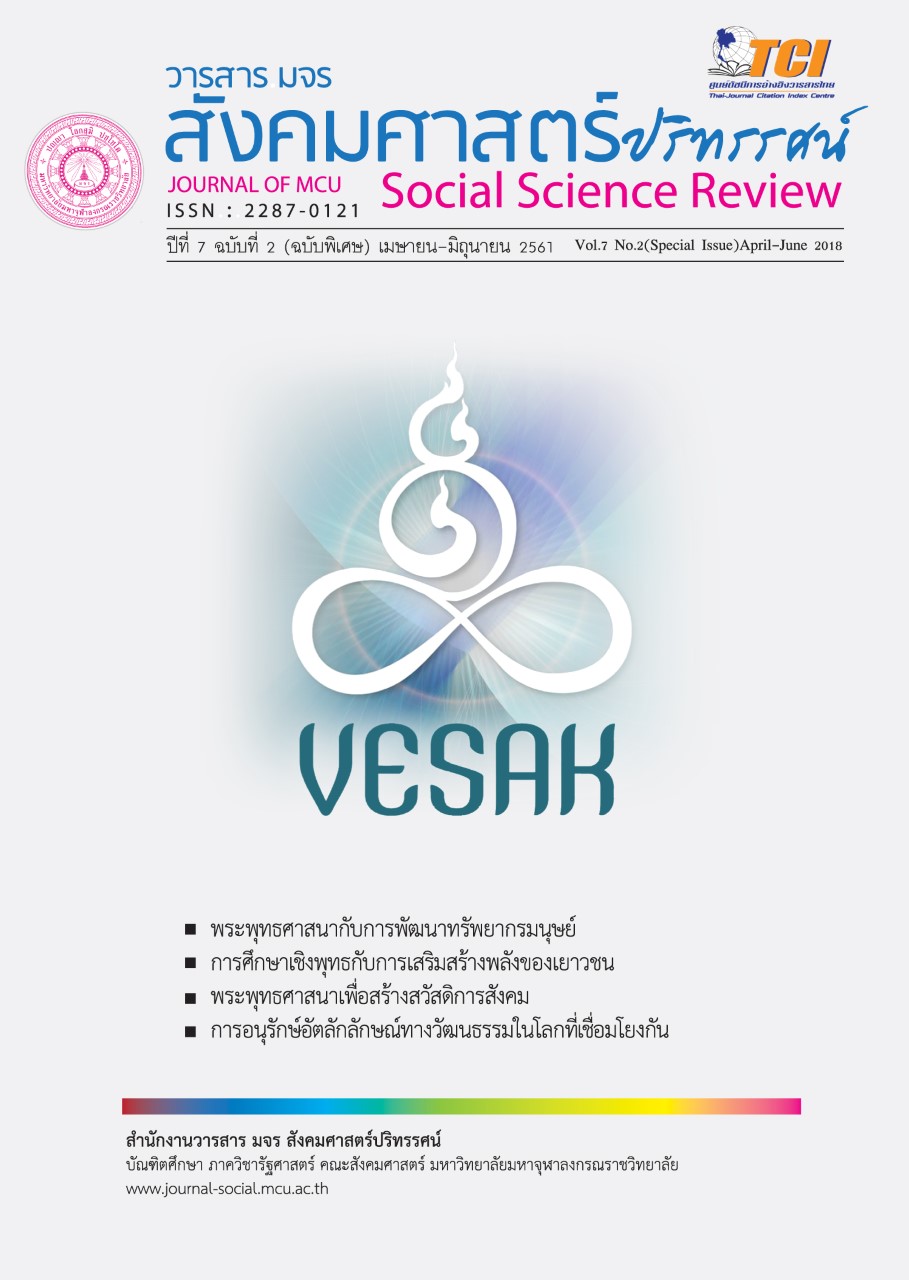รูปแบบการจัดการทุนมนุษย์เชิงพุทธขององค์กรปกครองส่วนท้องถิ่น จังหวัดนครสวรรค์
คำสำคัญ:
การจัดการ ทุนมนุษย์เชิงพุทธ องค์กรปกครองส่วนท้องถิ่นบทคัดย่อ
บทความนี้ มีวัตถุประสงค์คือ 1) เพื่อศึกษาสภาพการจัดการทุนมนุษย์ในองค์กรปกครองส่วนท้องถิ่นจังหวัดนครสวรรค์ 2) เพื่อศึกษาการจัดการทุนมนุษย์เชิงพุทธในองค์กรปกครองส่วนท้องถิ่นจังหวัดนครสวรรค์ และ 3) เพื่อนำเสนอรูปแบบการจัดการทุนมนุษย์เชิงพุทธขององค์กรปกครองส่วนท้องถิ่นจังหวัดนครสวรรค์
ระเบียบวิธีวิจัยเป็นเชิงคุณภาพ (Qualitative Research) โดยเก็บรวบรวมข้อมูลจากเอกสารและงานวิจัยที่เกี่ยวข้อง ดำเนินการตามรูปแบบวิธีการวิจัยเอกสาร และเก็บรวบรวมข้อมูลโดยการสัมภาษณ์เชิงลึก จากผู้ให้ข้อมูลสำคัญ จำนวน 28 ท่าน พื้นที่ที่ใช้ในการวิจัยในครั้งนี้คือ องค์กรปกครองส่วนท้องถิ่นจังหวัดนครสวรรค์ เครื่องมือที่ใช้ในการวิจัยเป็นแบบสัมภาษณ์ที่มีโครงสร้างโดยนำข้อมูลที่ได้มาวิเคราะห์เนื้อหาการสังเคราะห์ข้อมูลเพื่อเข้าสู่กระบวนการถอดบทเรียนและค้นหารูปแบบการจัดการทุนมนุษย์เชิงพุทธขององค์กรปกครองส่วนท้องถิ่น จังหวัดนครสวรรค์ และดำเนินการสนทนากลุ่มเฉพาะโดยผู้เชี่ยวชาญจำนวน 9 ท่าน เพื่อทำการยืนยันความสมบูรณ์ของข้อมูล
ผลการวิจัยพบว่า
1.สภาพการจัดการทุนมนุษย์ในองค์กรปกครองส่วนท้องถิ่นในจังหวัดนครสวรรค์ พบว่า มีการจัดการทุนมนุษย์ ซึ่งถือว่าเป็นกำลังหลักในการขับเคลื่อนองค์กรไปสู่ความ สำเร็จตามเป้าหมายที่กำหนดไว้ โดยให้ความสำคัญกับการพัฒนาทุนมนุษย์ในระยะดูแลรักษา ในขณะที่ได้บุคลากรเข้ามาปฏิบัติหน้าที่ในองค์กรแล้ว ทั้งการพัฒนาศักยภาพ และการสร้างแรงจูงใจ ทั้ง 3 ด้าน คือ 1) ด้านการพัฒนาทักษะ ผู้บริหารได้ให้ความสำคัญในการจัดกิจกรรมที่ส่งเสริมทักษะการทำงานให้แก่บุคลากร ที่สอดคล้องกับหลักคุณธรรมจริยธรรมตามแนวทางของพระพุทธศาสนา ซึ่งให้เกิดผลลัพธ์ในการบริหารงานที่มีประสิทธิภาพสูง 2) ด้านการพัฒนาความรู้ มีกระบวนการอย่างชัดเจนในการส่งเสริมการพัฒนาความรู้ด้านวิชาการโดยการเข้าศึกษาต่อในระดับที่สูงขึ้นไป การเข้ารับการฝึกอบรมในหลักสูตรที่เกื้อกูลกับการปฏิบัติงานราชการ ศึกษาดูงานในพันธกิจที่ตนเองรับผิดชอบโดยตรง ในขณะเดียวกันได้ส่งเสริมให้บุคลากรได้ศึกษาเรียนรู้คุณธรรม จริยธรรม ผ่านศาสตร์พระราชาอย่างต่อเนื่อง 3) ด้านการพัฒนาทัศนคติบุคลากร พบว่า มีลักษณะที่เอื้ออาทรต่อกันสูง เพื่อให้เกิดความเสมอภาค เช่น การทำงานที่ตรงต่อเวลาและตรงต่อหน้าที่ที่รับผิดชอบไม่มีการก้าวก่ายหน้าที่กัน แต่มีการประสานงานกันเป็นอย่างดี
2. การจัดการทุนมนุษย์เชิงพุทธขององค์กรปกครองส่วนท้องถิ่นจังหวัดนครสวรรค์ โดยภาพรวม พบว่า องค์กรปกครองส่วนท้องถิ่นในจังหวัดนครสวรรค์ มีการจัดกิจกรรมที่ส่งเสริมคุณธรรมและจริยธรรม เพื่อประโยชน์ในการปฏิบัติงานราชการอย่างสม่ำเสมอผ่านกิจกรรม ดังนี้ 1) กิจกรรมที่พัฒนาด้านทักษะ เช่น การส่งเสริมให้บุคลากรเข้ารักการฝึก อบรม สัมมนา ในประเด็นที่เกี่ยวกับภาระหน้าที่ที่ตนรับผิดชอบ 2) กิจกรรมที่พัฒนาด้านความรู้ ได้เปิดโอกาสให้บุคลากรได้รับการศึกษาในระดับที่สูงขึ้นไป โดยสร้างแรงจูงใจจากการปฏิบัติงานที่ดี 3) กิจกรรมที่พัฒนาด้านจิตใจ ความรู้สึกนึกคิด เช่น โครงการปฏิบัติธรรม เพื่อส่งผลที่ดีต่อการพัฒนาทุนมนุษย์ด้านทัศนคติ
3. รูปแบบการจัดการทุนมนุษย์เชิงพุทธขององค์กรปกครองส่วนท้องถิ่นจังหวัดนครสวรรค์โดยการนำหลักสัปปุริสธรรม 7 มาบูรณาการเข้ากับการพัฒนาทุนมนุษย์ทั้ง 3 ด้าน คือ การจัดการทุนมนุษย์ด้านทักษะ การจัดการทุนมนุษย์ด้านความรู้ และการจัดการทุนมนุษย์ด้านทัศนคติ พบว่า การประยุกต์ใช้หลักสัปปุริสธรรม 7 เป็นรูปแบบในการจัดการทุนมนุษย์เชิงพุทธได้อย่างเหมาะสม โดยผ่านกิจกรรมส่งเสริมให้บุคลากรรู้เท่าทันต่อสถานการณ์ 7 ประการ ดังนี้ 1) ให้รู้จักวิเคราะห์สาเหตุของสถานการณ์ว่าเมื่อกระทำสิ่งนี้จะได้ผลตอบแทนเป็นความสุข ที่ส่งเสริมให้บุคลากรทำงานอย่างเป็นระบบ ในด้านการวางแผน การดำเนินงานตามแผน การวัดและประเมินผลสำเร็จ พร้อมทั้งการปรับปรุงการทำงานอย่างสมเหตุสมผล 2) ให้รู้จักการประเมินผลลัพธ์ เพื่อลดความเสี่ยงที่เกิดขึ้นในอนาคต 3) ให้รู้จักประพฤติตนให้เหมาะสมแก่ภาวะของตน ส่งเสริมให้บุคลากรประเมินตนเองจากผลการดำเนินงานที่ผ่านมาและพัฒนาจุดด้อย 4) ให้รู้จักประมาณ ดำเนินชีวิตให้อยู่ในสภาพที่เหมาะสม ส่งเสริมให้บุคลากรใช้ทรัพยากรอย่างประหยัดคุ้มค่าและปฏิบัติตามหลักปรัชญาเศรษฐกิจพอเพียง 5) รู้จักเวลาที่เหมาะสมในการทำกิจกรรมต่างๆ
เอกสารอ้างอิง
Boromarajchanok Institute (Doctor of thesis). Graduate
School: Silpakorn University.
Mark A. Huselid. (1995). The impact of human resource management practices on
turnover, Productivity, and Corporate Financial Performance”,
Academy of Management Journal, 38, 635-672.
Kengsak Bunma. (2007). Development of the potential of assistant administrators
of private vocational schools under Industrial development in the
country. (Doctor of thesis).Educational Administration : Silpakorn University.
Phadungsit Chamnanborirak (2009). Model of human resource development in
medical service. Community Emergencies: A Case Study in
Thailand and the Lao People's Democratic Republic. (Doctor of
Philosophy thesis). Rajabhat Loei University.
Wanchai Suktam (2012). Human capital development, Buddhist way of life in globalization (Master of Thesis). Graduate School: Valaya Alongkorn Rajabhat University Under The Royal Patronage,
ดาวน์โหลด
รูปแบบการอ้างอิง
ฉบับ
ประเภทบทความ
สัญญาอนุญาต
ลิขสิทธิ์ (c) 2020 วารสาร มจร สังคมศาสตร์ปริทรรศน์

อนุญาตภายใต้เงื่อนไข Creative Commons Attribution-NonCommercial-NoDerivatives 4.0 International License.
เพื่อให้เป็นไปตามกฎหมายลิขสิทธิ์ ผู้นิพนธ์ทุกท่านต้องลงลายมือชื่อในแบบฟอร์มใบมอบลิขสิทธิ์บทความให้แก่วารสารฯ พร้อมกับบทความต้นฉบับที่ได้แก้ไขครั้งสุดท้าย นอกจากนี้ ผู้นิพนธ์ทุกท่านต้องยืนยันว่าบทความต้นฉบับที่ส่งมาตีพิมพ์นั้น ได้ส่งมาตีพิมพ์เฉพาะในวารสาร มจร สังคมศาสตร์ปริทรรศน์ เพียงแห่งเดียวเท่านั้น หากมีการใช้ภาพหรือตารางหรือเนื้อหาอื่นๆ ของผู้นิพนธ์อื่นที่ปรากฏในสิ่งตีพิมพ์อื่นมาแล้ว ผู้นิพนธ์ต้องขออนุญาตเจ้าของลิขสิทธิ์ก่อน พร้อมทั้งแสดงหนังสือที่ได้รับการยินยอมต่อบรรณาธิการ ก่อนที่บทความจะได้รับการตีพิมพ์ หากไม่เป็นไปตามข้อกำหนดเบื้องต้น ทางวารสารจะถอดบทความของท่านออกโดยไม่มีข้อยกเว้นใดๆ ทั้งสิ้น





